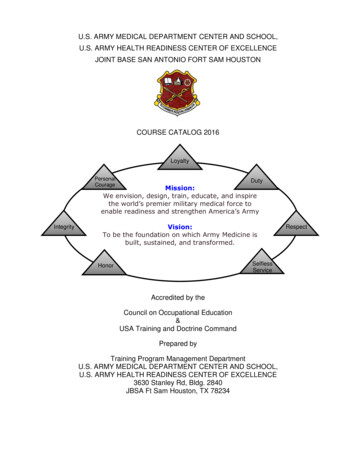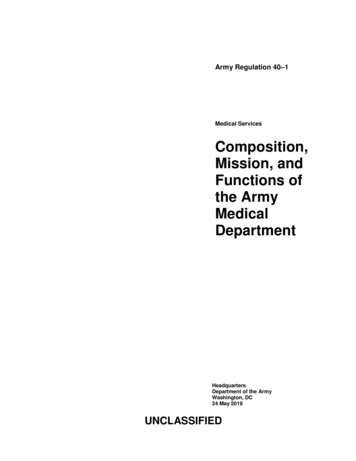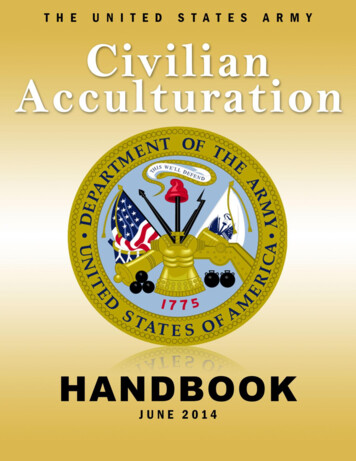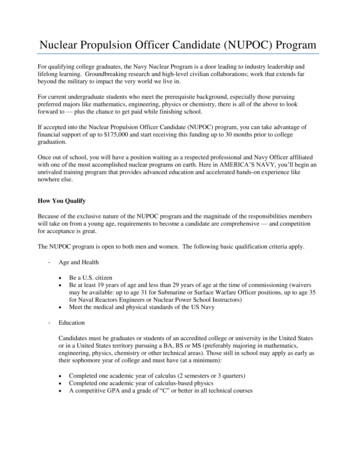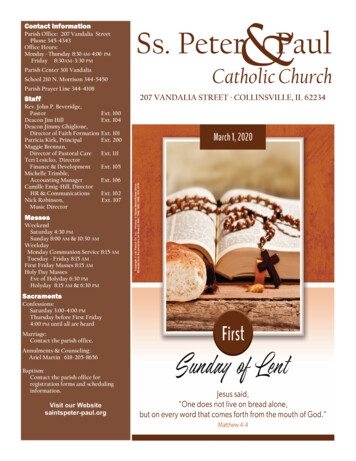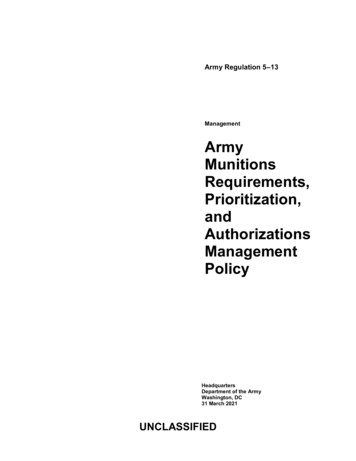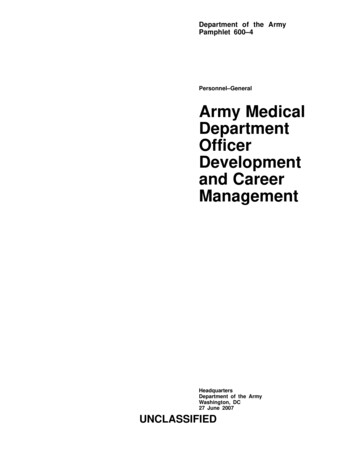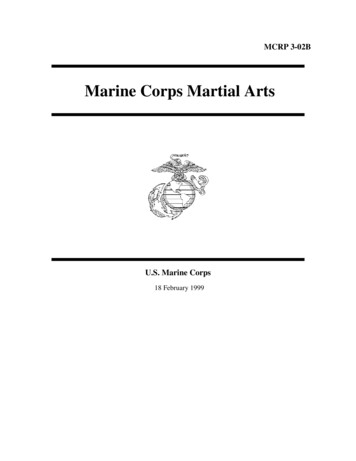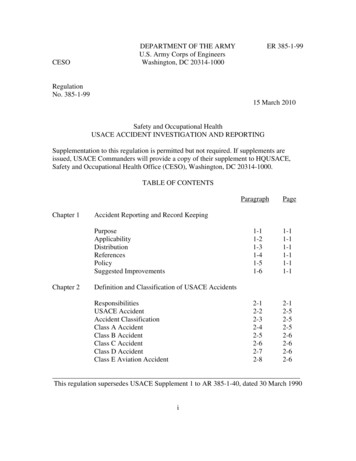
Transcription
CESODEPARTMENT OF THE ARMYU.S. Army Corps of EngineersWashington, DC 20314-1000ER 385-1-99RegulationNo. 385-1-9915 March 2010Safety and Occupational HealthUSACE ACCIDENT INVESTIGATION AND REPORTINGSupplementation to this regulation is permitted but not required. If supplements areissued, USACE Commanders will provide a copy of their supplement to HQUSACE,Safety and Occupational Health Office (CESO), Washington, DC 20314-1000.TABLE OF CONTENTSParagraphChapter 1Accident Reporting and Record olicySuggested ImprovementsChapter 2-42-52-62-72-82-12-52-52-52-62-62-62-6Definition and Classification of USACE AccidentsResponsibilitiesUSACE AccidentAccident ClassificationClass A AccidentClass B AccidentClass C AccidentClass D AccidentClass E Aviation AccidentThis regulation supersedes USACE Supplement 1 to AR 385-1-40, dated 30 March 1990i
ER 385-1-9915-Mar 10Paragraph2-92-102-11Class F Aviation IncidentRecordable Public FatalityOther Reportable AccidentsChapter 3InvestigationsAccident InvestigationsWhat to Investigate and ReportTypes of Accidents and IncidentsNon-Reportable EventsInitial Notification and Reporting of AccidentsReportingDetermining Accountability for USACE AccidentsCategories of Accident Investigation ReportsStaffing and Review of Accident InvestigationReportsAccident Boards of Investigation (BOI)Changes to Accident Reports and Request forExtension of Submission Time LimitsMaintaining Accident RecordsDeviationsAccident Scene PreservationAccident Scene InvestigationAccess to Information from Other InvestigationsAccess to Information Collected by AccidentInvestigation BoardsSafeguarding Accident InformationRelease of Information from Limited Use &General Use Safety AccidentInvestigation ReportsLegal Accident InvestigationsInjury and Accident RatesChapter 03-213-163-183-184-14-1Log of Work-Related Injuries & IllnessesOSHA LogsAppendix A – Accident Boards of InvestigationA-1Appendix B – Member of the Recreating Public AccidentsB-1Appendix C – OSHA Record Keeping RequirementsC-1ii
ER 385-1-9915 Mar 10ParagraphPageAppendix D – Accident Reporting Decision MatrixesD-1Appendix E – Notification and Reporting Requirements MatrixE-1GlossaryGlossary-1List of Figures:Figure 1 - DA Form 7306-R; Worksheet for Telephonic Notification ofGround AccidentA-6Figure 2 - Example of Board Appointment OrdersA-22Figure 3 - Public Recreation Accident WorksheetB-4iii
ER 385-1-9915 Mar 10CHAPTER 1Accident Reporting and Record Keeping1-1. Purpose. This Engineering Regulation (ER) establishes policies and procedures andassigns responsibilities for initial notification, investigation, preparation and submissionof reports of U.S. Army Corps of Engineers (USACE) accidents and accidentrecordkeeping procedures. This regulation also serves as mandatory guidance forimplementing accident reporting and record keeping requirements published inOccupational Safety and Health Act (OSHA) (Public Law 91-596), Executive Order12196, 29 CFR 1960 (OSHA), AR 385-10; The Army Safety Program, DA Pamphlet385-40; Army Accident Investigation and Reporting and DODI 6055.7; AccidentInvestigation, Reporting and Record Keeping.1-2. Applicability. This regulation applies to USACE elements, to include Contractors,Vendors and Subordinate Commands.1-3. Distribution. This publication is available in electronic media only.1-4. References.a. AR 385-10 The Army Safety Programb. DA Pamphlet 385-10 Army Safety Programc. DA Pamphlet 385-40 Army Accident Investigation and Reportingd. DA Form 285 Series.1-5. Policy. USACE policy is to investigate and report USACE accidents in order toprevent recurrences and to comply with OSHA, Department of Defense (DoD), Armyand other regulatory requirements. All USACE accidents shall be reported (to includeimmediate notification), investigated, recorded and analyzed in accordance with therequirements of this regulation, 29 CFR 1960, DoDI 6055.7, AR 385-10, DA Pamphlet385-40 and EM 385-1-1.1-6. Suggested Improvements. Users are invited to send comments and suggestedimprovements on DA Form 2028 (Recommended Changes to Publications and BlankForms)1-1
ER 385-1-9915 Mar 10CHAPTER 2Definition and Classification of USACE Accidents2-1. Responsibilities.a. The Commander, USACE will establish overall USACE accident reporting andrecordkeeping policy.b. The HQUSACE Safety and Occupational Health Office (CESO) shall:(1) Establish and maintain a USACE accident reporting, recordkeeping, and analysissystem to track and analyze USACE Military and Civilian Personnel injuries andillnesses, USACE accidental property damage, USACE contractor personnel injuries andillnesses and contractor accidental property damage, member of the public fatal injuriesand accidental injuries, illnesses and property damage caused by USACE and USACEcontractor activities.(2) Establish accident reporting, recording, and recordkeeping requirements forUSACE to include requirement for subordinate Commands to report Civilian andMilitary personnel injuries and illnesses and USACE property damage accidents to theUS Army Combat Readiness and Safety Center (CRSC), Building 4905, Fort Rucker,AL, 36362-5363 for entry into the Loss Reporting Automation System (LRAS) and theArmy Safety Management Information System (ASMIS).(3) Collect accident information, and distribute abstracts and/or lessons learned asappropriate.(4) Analyze accident information to identify causal factors and trends, and developUSACE-wide accident prevention measures.(5) Review and determine disposition of all USACE accident reports, includingBoard of Investigation (BOI) reports, lessons learned, and abstract summaries.(6) Disseminate abstracts and accident lessons learned to subordinate commands.c. HQUSACE Office of Counsel shall:(1) Coordinate with CESO in developing Freedom of Information Act (FOIA)policy for all safety reports.2-1
ER 385-1-9915 Mar 10(2) Ensure that Counsel Offices in Subordinate Commands coordinate with localSafety Offices and the CRSC on releasing safety reports in response to FOIA requests.(See AR 385-10, Chapter 3, Paragraph 29.)d. MSC Commanders/Directors shall:(1) Perform quality control to evaluate and assure the accident investigation,reporting, and recordkeeping of MSC and subordinate Commands are compliant with thisregulation.(2) Analyze regional accident experience, causal factors, and trends to developpreventive measures for systemic hazards.(3) Provide consolidated MSC accident data as required by HQUSACE.(4) Appoint accident BOI by memorandum assuring the investigation team has theknowledge, training, and experience necessary to complete a thorough and qualityinvestigation. See Appendix A.(5) Require briefings by subordinate Commanders/Directors to the Board appointingOfficer on all Class A fatalities and selected other BOIs as determined by the MSC SOHoffice in conjunction with the HQUSACE SOH Office.(6) Provide the USACE Commander a personal briefing (face to face or VTC) onGovernment employee fatal accidents within 30 days after completion of the BOI report.The briefing shall describe the causes, lessons learned, and actions taken to preventsimilar occurrences in the future and recommended changes in regulations, policy, andprocedures for Division, MSC, or Corps-wide application.(7) Review each BOI report to assure the report has determined that all accidentcauses and corrective actions have been adequately addressed.(8) Request additional clarification/research from the Board if it is determined thatall accident causes and corrective actions have not been adequately addressed.(9) Forward BOI with associated cover letter to CESO if it is determined that allaccident causes and corrective actions have been adequately addressed.e. Commanders/Directors of Subordinate Commands (Divisions, Districts, Centers,Laboratories, and Field Operating Activities (FOAs)) shall:(1) Ensure that all accidents are reported in accordance with this regulation.2-2
ER 385-1-9915 Mar 10(2) Ensure that accidents are investigated and analyzed to the extent necessary toidentify causal factors and systemic deficiencies. Develop and implementcountermeasures to prevent recurrence of similar accidents.(3) Ensure that all Civilian and Military personnel Class A - D injuries and illnessesand USACE property damage accidents are entered into the Army Loss ReportingAutomation System (LRAS) or forward accident investigation report and associated dataon appropriate DA 285 series form (DA 285 or DA 285 AB-R) to Commander, US ArmyCombat Readiness and Safety Center (CRSC), Building 4905, Fort Rucker, AL, 363625363 for entry into the LRAS.(4) Ensure that all contractor Class A - D injuries and illnesses, recordable memberof the public injuries and illnesses, and contractor property damage accidents are enteredinto the ENGLink Incident Reporting System (IRS) and the ENG 3394 Form. When theArmy Safety Management Information System (ASMIS) is activated, it will replace theuse of the ENG 3394 Form.(5) Ensure that consolidated accident data is forwarded through MSC to CESO.(6) Ensure that a Report of Serious Accident (ROSA) is forwarded, as soon asreasonably possible but within 8 hours of the occurrence of the accident, to higherUSACE Commands and CESO for each known or potential Class A or B accident and allother accidents for which a BOI is established. Upon release, the ROSA willautomatically be forwarded to CESO, with a copy furnished to the next higher levelCommand.(7) Ensure only knowledgeable and experienced personnel conduct accidentinvestigations and serve as members of an accident BOI. See Appendix A.(8) Ensure that an abstract summary, of all accidents where a BOI is required, iscompleted in accordance with this regulation. Ensure that a copy of the abstract isforwarded with the BOI and that a copy is submitted to the Lessons Learned system. .(9) Determine the duty status of USACE employees involved in accidents if dutystatus is in question.(10) In the event a USACE Military personnel, Civilian or contractor employee isfatally injured, while in a duty status, schedule an appointment and brief the next higherlevel Commander within 30 days after the BOI has been signed by the Commanderappointing the BOI. The purpose of the briefing is to explain the causes of the accident,any lessons learned, and actions taken to prevent future occurrences. The briefing should2-3
ER 385-1-9915 Mar 10be in person, but may be accomplished by video teleconference or telephone, ifcircumstances so warrant, as determined by the Commander being briefed.(11) Report other high visibility accidents, (e.g., accidents resulting in less than 500,000 property loss, permanent disability injuries to USACE employees, mishaps thatcould cause unfavorable publicity to USACE and serious near misses) to the next higherlevel Command, USACE Deputy Commander, or USACE Commander on a selectedbasis. The determination for these briefings shall be made by the HQ USACE Chief,Safety and Occupational Health Office (CESO) in consultation with the USACE DeputyCommander. When required, this briefing shall take place within 30 days after thecompletion of the BOI.(12) Assure the local Command’s Injury Compensation Program Administratorfurnishes the Command’s Safety and Occupational Health Office a copy of the OSHAreport of injury (OSHA 301) electronically generated as a result of Federal EmployeeCompensation Act (FECA) claims to ensure that all accidents are reported andinvestigated, as appropriate.NOTE: Functions 6.e. (1) – (11) are normally delegated to the local Command Safetyand Occupational Health Office.f. Supervisors shall:(1) Assure all employees are trained in their rights and responsibilities for accidentreporting and recordkeeping.(2) Assure all accidents which occur within their area of responsibility areinvestigated and reported in accordance with this regulation.g. Contracting Officer’s Representatives shall:(1) Assure contractors are informed of their responsibilities for accident reportingand investigation.(2) Assure all accidents which occur within their area of responsibility areinvestigated and reported in accordance with this regulation.h. Freedom of Information Act (FOIA) Officers shall:(1) Assist in preserving accident reports for use in accident prevention purposesexclusively.2-4
ER 385-1-9915 Mar 10(2) Assure any release of information from accident records is in accordance withthis regulation(3) Consult with the USACE FOIA Officer for guidance on the release of accidentrecords.2-2. USACE Accident. A USACE accident is defined as an unplanned event, or seriesof events, which results in one or more of the following:a. Occupational illness to USACE Military or Civilian personnel.b. Injury to on-duty USACE Civilian personnel.c. Injury to USACE Military personnel on or off-duty.d. Injury to volunteers registered in the USACE Volunteer Clearinghouse Program.e. Damage to USACE property.f. Damage to public or private property and/or injury or illness to members of thepublic caused by USACE operations or USACE contractor (on-site) operations (i.e.,USACE/USACE contractor had a causal or contributing role in the accident.)g. Injury or occupational illness to on-duty contractor employees supervised byUSACE personnel on a day-to-day basis.h. Injury or occupational illness to on-duty contractors/subcontractors or damage tocontractor/subcontractor property, which occurs on-site and accident reporting to USACEis contractually required.i. Injury or death to members of the public who are recreating at USACE-owned oroperated areas where CFR Title 36, Chapter III, Part 327, Parks, Forests, and PublicProperty is applicable.2-3. Accident Classification. Accident classes are used to determine the appropriatereporting, investigating, and recording procedures. USACE accident classifications are asfollows:2-4. Class A Accident. A USACE accident in which the resulting total cost of USACEor USACE contractor property damage is 2,000,000 or more; an USACE aircraft isdestroyed, missing, or abandoned, or an injury and/or occupational illness results in afatality or permanent total disability to USACE Military or Civilian personnel or2-5
ER 385-1-9915 Mar 10contractor personnel. Persons who are missing and/or presumed dead as a result of anaccident shall be reported as fatalities. Class A accidents are recordable and require aPreliminary Accident Notification, a Report of Serious Accident, an accidentinvestigation report, and a Board of Investigation.2-5. Class B Accident. A USACE accident in which the resulting total cost of USACEor USACE contractor property damage is 500,000 or more, but less than 2,000,000; aninjury and/or occupational illness results in permanent partial disability to USACEMilitary or Civilian personnel or contractor personnel, or when three or more personnelare hospitalized as inpatients as the result of a single occurrence. Class B accidents arerecordable and require a Preliminary Accident Notification, a Report of Serious Accident,an accident investigation report, and a Board of Investigation.2-6. Class C Accident. A USACE accident in which the resulting total cost of propertydamage is 50,000 or more, but less than 500,000; a nonfatal injury or occupationalillness to USACE Military or Civilian personnel or contractor personnel that causes oneor more days away from work or training beyond the day or shift on which it occurred, ordisability at any time (that does not meet the definition of Class A or B and is a lostworkday case). Class C accidents are recordable and require a Preliminary AccidentNotification and an accident investigation report.2-7. Class D Accident. A USACE accident in which the resulting total amount ofproperty damage is 2,000 or more, but less than 50,000; a non-fatal injury oroccupational illness to USACE Military or Civilian personnel or contractor personnelresulting in restricted work, transfer to another job, medical treatment greater than firstaid, needle stick injuries and cuts from sharps that are contaminated from anotherperson’s blood or other potentially infectious material, medical removal under medicalsurveillance requirements of an OSHA standard, occupational hearing loss that meetsOSHA recordability criteria, or a work-related tuberculosis case. Class D accidents arerecordable and require a Preliminary Accident Notification and an accident investigationreport.2-8. Class E Aviation Accident. See AR 385-10, Chapter 3 for reporting andrecordkeeping requirements.2-9. Class F Aviation Incident. See AR 385-10, Chapter 3 for reporting andrecordkeeping requirements.2-10. Recordable Public Fatality. An accident which results in the death of one or moremembers of the public who are recreating at USACE-owned or operated areas whereCFR Title 36, Chapter III, Part 327, "Parks, Forests, and Public Property" is applicable.These accidents are recordable and require a Preliminary Accident Notification and anaccident investigation report.2-6
ER 385-1-9915 Mar 102-11. Other Reportable Accidents.a. Any other accident that results in injury or illness to a member of the public ordamage to private/public property due to Corps or Corps contractor (on-site) operationswhich results in a total cost of property damage of 500,000 or more or an injury and/orillness results in a fatality or permanent total disability. These accidents are recordableand require a Preliminary Accident Notification, accident investigation report, and BOI.NOTE: Public recreation accidents are not included in this classification but rather underthe guidance included in paragraph 2-10 above.b. USACE accidents which result in any injury, illness, or property damage otherthan those listed above in this section which the local Commander determines may bebeneficial in accident trend analysis or may result in improvements to the facility’sdesign safety by conducting an accident investigation. These accidents may be reportedand documented with a Preliminary Accident Notification, an accident investigationreport and/or BOI at the discretion of the local Command.2-7
ER 385-1-9915 Mar 10CHAPTER 3Investigations3-1. Accident Investigations.a. All accidents shall be investigated to determine the extent of injuries, amount ofproperty damage, and whether or not the accident meets the criteria for recordability.b. Recordable accidents shall be investigated to the degree necessary to identify theimmediate mistakes/errors/failures, and system inadequacies which may have caused, orcontributed to, the accident. The techniques and procedures are provided in DA PAM385-40c. Recommendations shall be provided that will remedy the causes and minimizethe chances for similar recurrences.3-2. What to Investigate and Report. Responsible supervisors and managers shall betrained and shall investigate and report USACE and public recreation accidents to thelocal Command's Safety and Occupational Health Office. Contractor site safety andhealth officers shall be trained and shall investigate and report contractor accidents to theContracting Officer’s Representative. Accidents that result in one or more of thefollowing shall be reported:a. Injuries or Occupational Illnesses to the following:(1) on-duty or off-duty Military personnel.(2) on-duty USACE Civilian personnel, including non-appropriated fund (NAF)employees, and foreign nationals employed by USACE when the accident is incurredduring the performance of work-related duties.(3) on-duty contractor employees who are on the contract work site and accidentreporting to USACE is contractually required.(4) on-duty contractors supervised by USACE personnel on a day-to-day basis (i.e.,"Government Direct Contractors", see glossary.)(5) non-USACE personnel as a result of USACE or contractor operations.(6) Soldier training related deaths. See AR 385-10, Chapter 3, Subparagraph 3-5a.(4) and glossary for definition of a training related death.(7) persons who are missing and/or presumed dead, as the result of an accident.3-1
ER 385-1-9915 Mar 10(8) members of the recreating public who are recreating at USACE owned oroperated areas where CFR Title 36, Chapter III, Part 327, "Parks, Forests, and PublicProperty" is applicable.(9) volunteers registered in the USACE Volunteer Clearinghouse Program.b. Property Damage to the following:(1) Government-owned property, including Government-furnished material (GFM),or Government-furnished property (GFP), or Government-furnished equipment (GFE)provided to a contractor.(2) contractor/subcontractor property damage which occurs on-site and whereaccident reporting to USACE is contractually required.(3) public or private property caused by USACE or contractor (on-site) operations(i.e., USACE had a causal or contributing role in the accident.)c. Special reporting requirements exist for personnel injury, occupational illness,and property damage for the following types of accidents which are addressed in DA Pam385-40:(1) Motor Vehicle Accidents(2) Aircraft accidents(3) Commercial carrier/transportation accidents(4) Marine accidents(5) Fires(6) Chemical agent accidents(7) Explosives accidents(8) Ionizing and non-ionizing radiation accidents(9) Nuclear accidents(10) Biological defense accidents3-2
ER 385-1-9915 Mar 103-3. Types of Accidents and Incidents. When two or more types of vehicles, such as anArmy Motor Vehicle (AMV) and an Army Combat Vehicle (ACV) are involved in anaccident, the type of equipment operated by the individual deemed most responsible shalldetermine the accident type. This process shall also be followed in determining othertypes of accidents (for example, fire, marine, explosives.) See DA Pam 385-40 foradditional detail.3-4. Non-Reportable Events. (See AR 385-10, Chapter 3, subparagraph 3-7 for greaterdetail.)The following events are not reportable accidents:a. Damage, loss, injury, or illness caused by enemy forces.b. Malfunction or failure of parts that are normally subject to fair wear and tear andhave a fixed useful life less than the complete system/unit are not considered accidents ifthe malfunction or failure is the only damage and the sole action is to replace or repairthat component part. The only exception is that all fires or fire damage involvingcomponent parts must be reported.c. Damage to USACE/contractor equipment or property that is planned, intended, orexpected during authorized testing or intentional destruction is not considered anaccident.d. Property damage as a result of vandalism, riots, civil disorders, or felonious actssuch as arson. Damage to USACE/contractor aircraft, vehicles, or any other propertywhich occurs after property has been stolen is not reportable as an accident. Damage toUSACE/contractor property which occurs when an individual misappropriates propertyto which they are not authorized to operate or use, shall not be reported as an accident.e. Deliberate damage to USACE/contractor property or personnel.f. Accidents occurring during the transportation of USACE/contractor material bycommercial carrier.g. USACE equipment leased, on bailment, or loaned to contractors, or otherGovernmental agencies or Governments when the lessee has assumed risk of damage orloss. (Note in the case of USACE contractor use of equipment it may be recordable as acontractor accident.)h. Injuries associated with non-occupational diseases, when the disease, not theinjury, is the proximate cause of the lost time, such as diabetes and its resultantcomplications like loss of vision. Complications of the injury (such as the infection of acut aggravated by a work—related activity) that result in lost time are reportable.3-3
ER 385-1-9915 Mar 10i. Suicide or attempted suicide, homicide, or intentionally self—inflicted injuries.Violence in the workplace events shall be reported to the U.S. Department of Labor inaccordance with 29 CFR 1904.5.j. Injuries resulting from altercations, attack, or assault, unless incurred in theperformance of official duties (for example, MPs).k. Injuries sustained before entry into military service or employment byUSACE/contractor, unless specifically aggravated by current tenure of service.l. Illnesses caused by specific organisms and toxins (such as food-borne disease),unless the disease is directly related to, or the result of, the worker’s employment.m. Minimum stress and strain (simple, natural, and nonviolent body positions oractions, as in dressing, sleeping, coughing, or sneezing.) These are injuries unrelated toaccident-producing agents or environments normally associated with active participationin daily work or recreation.n. Hospitalization for treatment when the patient is retained beyond the day ofadmission solely for administrative reasons. Hospitalization for observation oradministrative reasons not related to the immediate injury or occupational illness.o. Injuries or fatalities to persons in the act of escaping from or eluding military orcivilian custody or arrest.p. Death due to natural causes unrelated to the work environment as determined bya physician. (This may be determined by autopsy.)q. Adverse bodily reactions resulting directly from the use of drugs under thedirection of competent medical authority.r. Death or injury resulting solely from the use of alcohol, illegal drugs, or othersubstances.s. Pre-existing injuries musculoskeletal disorders unless aggravated or acceleratedby current employment.Civilian / Contractor employee injuries / illnesses are reportable but not recordable if theymeet the following criteria:3-4
ER 385-1-9915 Mar 10(1) At the time of the injury or illness, the individual was present in the workenvironment as a member of the general public rather than as an employee (i.e., theindividual is on-site visiting in a non-work status unrelated to his employment. Forexample, an employee was on-site, in a non-work status to borrow personally ownedtools from a co-worker.)(2) The injury or illness involves signs or symptoms that surface at work but resultsolely from a non-work-related event or exposure that occurs outside the workenvironment and not aggravated by the work environment. (Note – If it is not readilyknown whether an injury/illness/fatality is work-related, a physician’s determination maybe required.)(3) The injury or illness occurs when the employee is in a travel status and either:(a) the employee has established a “home away from home” by checking into ahotel/motel. Injuries and illnesses that occur while in “home away from home” status arenot recordable. For example, if an employee slips in the hotel shower and is injured, theinjury is not recordable, or(b) the employee has detoured for personal reasons. For example, while on TDY, ifan employee takes a side trip for a vacation, to go sight-seeing, shopping, etc., and isinjured, the injury is not recordable.(4) The injury or illness results solely from voluntary participation in a wellnessprogram or in a medical, fitness, or recreational activity such as blood donation, physicalexamination, flu shot, exercise class, racquetball, or baseball.(5) The injury or illness is solely the result of an employee eating, drinking, orpreparing food or drink for personal consumption (whether bought on the employer'spremises or brought in). For example, if the employee is injured by choking on asandwich while in the employer's establishment, the case would not be considered workrelated.Note: If the employee is made ill by ingesting food contaminated by workplacecontaminants (such as lead), or gets food poisoning from food supplied by the employer,the case would be considered work-related.(6) The injury or illness is solely the result of an employee doing personal tasks(unrelated to their employment) at the establishment outside of the employee's assignedworking hours.(7) The injury or illness is solely the result of personal grooming, self-medication fora non-work-related condition, or is intentionally self-inflicted.3-5
ER 385-1-9915 Mar 10(8) The injury or illness is caused by a motor vehicle accident and occurs in aUSACE parking lot or on a USACE access road while the employee is commuting to orfrom work.(9) The illness is the common cold or flu (Note: contagious diseases such astuberculosis, brucellosis, hepatitis A, or plague are considered work-related if theemployee is infected at work).(10) Hearing loss, if a physician or other licensed health care determines that thehearing loss is not work-related or has not been significantly aggravated by occupationalnoise exposure.(11) Tuberculosis, if there is evidence that the case did not arise from a workplaceexposure.(12) The illness is a mental illness. Mental illness shall not be considered workrelated unless the employee voluntarily provides USACE with an opinion from aphysician or other licensed health care professional with appropriate training andexperience (psychiatrist, psychologist, psychiatric nurse practitioner, etc.) stating that theemployee has a mental illness that is work-related.(13) Medical and first aid procedures if they meet the following criteria:(a) Needle sticks and sharps, if the needle sticks and cuts are from uncontaminatedsharps, and splashes or other exposures to blood or other potentially infectious material--provided the incident results in no diagnosis of a blood borne disease.(b) Medical removal if an employee is voluntarily removed below the thresholdsestablished in the standards.(c) Visits to a physician or licensed health care professional (PLHCP) solely fordiagnostic procedures such as x-rays, blood tests, or MRIs, observation and counseling--including follow-up visits.(d) Injuries and illnesses that require only first aid if they meet the following criteria: Using nonprescription medication at nonprescrip
on appropriate DA 285 series form (DA 285 or DA 285 AB-R) to Commander, US Army Combat Readiness and Safety Center (CRSC), Building 4905, Fort Rucker, AL, 36362-5363 for entry into the LRAS. (4) Ensure that all contractor Class A - D injuries and illnesses, recordable member
